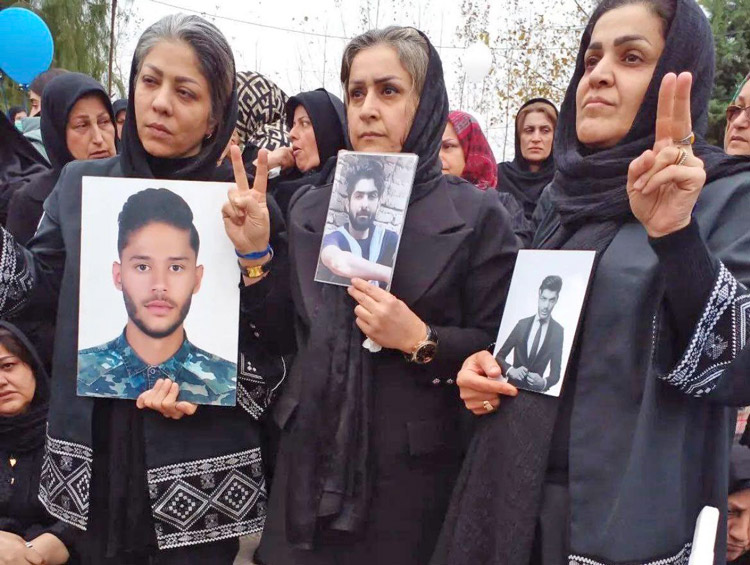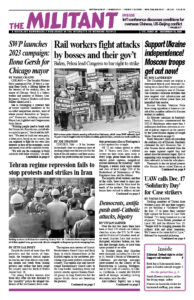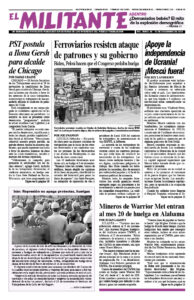Despite the death of more than 400 protesters and the arrests of thousands, the bourgeois clerical regime in Iran has not been able to stop working people and youth from joining protests and strikes that have swept the country since the death of Mahsa Amini Sept. 16.
The young Kurdish woman died three days after she was detained by the “morality” police for alleged violations of the reactionary dress code.
The regime sent convoys of Islamic Revolutionary Guard Corps and Basij thugs to attack demonstrators in the Kurdish region in the northwest, provoking even more protests around the country. The regime also sent heavily armed Revolutionary Guard units to the Iraqi border, launching drone and missile attacks against Iranian-Kurdish groups in Iraqi Kurdistan that the regime falsely claims are fomenting the protests.
“We demand the immediate withdrawal of all oppressive armed forces from Kurdistan and all Kurdish cities and we demand the unconditional release of all prisoners,” the Haft Tappeh Sugarcane Workers Union said in a statement Nov. 25, as well as an end to all attacks on the Kurdish region of Iraq. “The workers of Kurdistan are our brothers and sisters.”
Over 200 Sunni clerics, part of the government-recognized religious establishment in the Kurdish region of Iran, read a statement in their mosques Nov. 20 and 21 backing the protests. Sunni religious figures in the Baluchistan region — where the mostly Sunni Baluch, like Kurds, face discrimination by the Shiite-dominated regime — called on the “Shiite clergy and authorities to break their silence” and condemn the repression.
U.S. rulers lie about 1979 revolution
The capitalist press in the United States portrays the reactionary regime in Iran as the product of the 1979 revolution that overthrew the U.S.-backed dictatorship of Shah Mohammad Reza Pahlavi. In fact it came out of a counterrevolution aimed at driving back what working people fought for in 1979.
Like his predecessors, Shah Pahlavi deepened the plunder of Iran by the imperialist powers on the backs of working people. Thousands were tortured over decades by the hated Savak secret police, as the shahs brutally enforced their rule.
Working people were at the forefront of a revolutionary movement of millions that forced Pahlavi to flee the country in 1979. They organized factory committees, known as shoras, and fought for workers control of job conditions. Oppressed nationalities from Kurds to Arabs fought for equal rights in jobs and schools, including the right to use their own languages. Women forced the regime to back off imposing its dress code for a while, and won the right to participate in and hold office in workers’ shoras.

But without their own independent working-class party, program and leadership, the toilers were not able to bring to power a government of workers and farmers. In 1982 far-reaching repression by the regime of Supreme Leader Ayatollah Ruhollah Khomeini made it impossible for communists and other currents in the working class to function.
In 1980, with U.S.-backing, the Saddam Hussein regime in Iraq invaded Iran. Defense of the country’s independence was popular and many workers were killed while defending it.
By 1983 the regime consolidated its counterrevolution. Iran’s rulers used their military and economic power to expand their counterrevolutionary reach into Iraq, Syria, Lebanon and divided Kurdistan. But they could not totally push working people out of politics at home. This experience is elaborated upon more fully in the Militant article “Revolution and Counterrevolution in Iran.”
Mass anti-government protests broke out in 2018 and 2019, showing the depth of working people’s anger toward the regime, including its military adventures abroad. Hundreds were killed by government forces during the demonstrations.
Standing on the shoulders of the 1979 revolution and the 2018 to 2019 protests, recent actions are inspiring thousands of workers to strike for both economic and political reasons. Some strikers, like other protesters, have taken up the chant of “Down with the dictator.”
On Nov. 26, welders at the Bafgh steel complex in Yazd province struck to protest unsafe conditions after two co-workers were killed in a gas explosion the day before.
The Union of Truckers and Drivers called a strike across the country on Nov. 26, shutting down factories, warehouses, ports and more. Owner-operators say the lack of fuel, the rising price of spare parts and all kinds of fees are making it hard to survive. “The people of Iran live on a sea of oil and gas, but you thieves don’t let anything reach the people,” the union said.
The strike has won solidarity. One farmer told the truck drivers union that even though farmers can’t get their crop to market, “We support these strikes.”
Debate in the ruling class
The inability of the government to stop the protests is widening rifts among factions in the ruling capitalist class.
The government-financed Iranian Student News Agency published a sharp debate Nov. 28 between Hamid Reza Taraqqi, a leader of the Islamic Coalition Party, which is closely allied with Supreme Leader Ali Khamenei’s party, and Ali Bagheri, the regime’s deputy foreign minister, who is allied with the “reformist” wing of the capitalist rulers.
Bagheri claimed he supports the slogan “Women, life, freedom,” which is popular at protests, but says “malicious elements” at demonstrations must be separated from the actions and treated as “enemies.”
Taraqqi called “Women, life, freedom” a slogan of supporters of Kurdish separatists and a cry to impose “a Western way of life,” which the government can’t tolerate.
The protests are impacting all classes in Iran. On Nov. 21, 250 translators in Iran issued a statement. “We will not return to the past,” it said. Together with millions of people across Iran they call for “the right to free speech and thought, to freedom of assembly and to freely choose a democratic government.”


